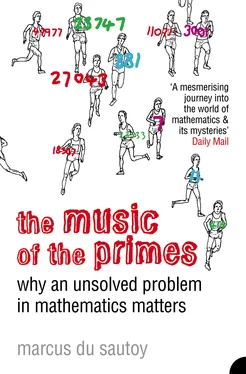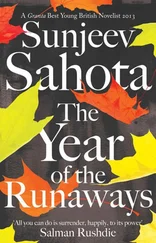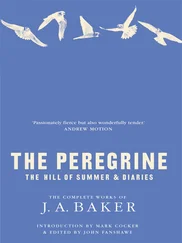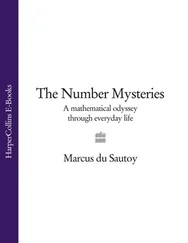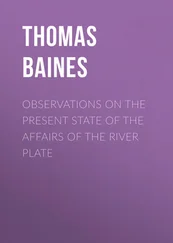The prime numbers up to 100 – mathematics’ irregular heartbeat.
Can you find a formula that generates the numbers in this list, some magic rule that will tell you what the 100th prime number is? This question has been plaguing mathematical minds down the ages. Despite over two thousand years of endeavour, prime numbers seem to defy attempts to fit them into a straightforward pattern. Generations have sat listening to the rhythm of the prime-number drum as it beats out its sequence of numbers: two beats, followed by three beats, five, seven, eleven. As the beat goes on, it becomes easy to believe that random white noise, without any inner logic, is responsible. At the centre of mathematics, the pursuit of order, mathematicians could only hear the sound of chaos.
Mathematicians can’t bear to admit that there might not be an explanation for the way Nature has picked the primes. If there were no structure to mathematics, no beautiful simplicity, it would not be worth studying. Listening to white noise has never caught on as an enjoyable pastime. As the French mathematician Henri Poincaré wrote, ‘The scientist does not study Nature because it is useful; he studies it because he delights in it, and he delights in it because it is beautiful. If Nature were not beautiful, it would not be worth knowing, and if Nature were not worth knowing, life would not be worth living.’
One might hope that the prime-number heartbeat settles down after a jumpy start. Not so – things just seem to get worse the higher you count. Here are the primes amongst the 100 numbers either side of 10,000,000. First, those below 10,000,000:
9,999,901 9,999,907, 9,999,929, 9,999,931, 9,999,937, 9,999,943, 9,999,971, 9,999,973, 9,999,991
But look now at how few there are in the 100 numbers above 10,000,000:
10,000,019, 10,000,079.
It is hard to guess at a formula that could generate this kind of pattern. In fact, this procession of primes resembles a random succession of numbers much more than it does a nice orderly pattern. Just as knowing the first 99 tosses of a coin won’t help you much in guessing the result of the 100th toss, so do the primes seem to defy prediction.
Prime numbers present mathematicians with one of the strangest tensions in their subject. On the one hand a number is either prime or it isn’t. No flip of a coin will suddenly make a number divisible by some smaller number. Yet there is no denying that the list of primes looks like a randomly chosen sequence of numbers. Physicists have grown used to the idea that a quantum die decides the fate of the universe, randomly choosing at each throw where scientists will find matter. But it is something of an embarrassment to have to admit that these fundamental numbers on which mathematics is based appear to have been laid out by Nature flipping a coin, deciding at each toss the fate of each number. Randomness and chaos are anathema to the mathematician.
Despite their randomness, prime numbers – more than any other part of our mathematical heritage – have a timeless, universal character. Prime numbers would be there regardless of whether we had evolved sufficiently to recognise them. As the Cambridge mathematician G.H. Hardy said in his famous book A Mathematician’s Apology , ‘317 is a prime not because we think so, or because our minds are shaped in one way or another, but because it is so , because mathematical reality is built that way.’
Some philosophers might take issue with such a Platonist view of the world – this belief in an absolute and eternal reality beyond human existence – but to my mind that is what makes them philosophers and not mathematicians. There is a fascinating dialogue between Alain Connes, the mathematician who featured in Bombieri’s email, and the neurobiologist Jean-Pierre Changeux in Conversations on Mind, Matter and Mathematics . The tension in this book is palpable as the mathematician argues for the existence of mathematics outside the mind, and the neurologist is determined to refute any such idea: ‘Why wouldn’t we see “π = 3.1416” written in gold letters in the sky or “6.02 × 10 23” appear in the reflections of a crystal ball?’ Changeux declares his frustration at Connes’s insistence that ‘there exists, independently of the human mind, a raw and immutable mathematical reality’ and at the heart of that world we find the unchanging list of primes. Mathematics, Connes declares, ‘is unquestionably the only universal language’. One can imagine a different chemistry or biology on the other side of the universe, but prime numbers will remain prime whichever galaxy you are counting in.
In Carl Sagan’s classic novel Contact , aliens use prime numbers to contact life on earth. Ellie Arroway, the book’s heroine, has been working at SETI, the Search for Extraterrestrial Intelligence, listening to the crackle of the cosmos. One night, as the radio telescopes are turned towards Vega, they suddenly pick up strange pulses through the background noise. It takes Ellie no time to recognise the drumbeat in this radio signal. Two pulses are followed by a pause, then three pulses, five, seven, eleven, and so on through all the prime numbers up to 907. Then it starts all over again.
This cosmic drum was playing a music that earthlings couldn’t fail to recognise. Ellie is convinced that only intelligent life could generate this beat: ‘It’s hard to imagine some radiating plasma sending out a regular set of mathematical signals like this. The prime numbers are there to attract our attention.’ Had the alien culture transmitted the previous ten years of alien winning lottery numbers, Ellie couldn’t have distinguished them from the background noise. Even though the list of primes looks as random a list as the lottery winnings, its universal constancy has determined the choice of each number in this alien broadcast. It is this structure that Ellie recognises as the sign of intelligent life.
Communicating using prime numbers is not just science fiction. Oliver Sacks in his book The Man Who Mistook His Wife for a Hat documents twenty-six-year-old twin brothers, John and Michael, whose deepest form of communication was to swap six-digit prime numbers. Sacks tells of when he first discovered them secretly exchanging numbers in the corner of a room: ‘they looked, at first, like two connoisseurs wine-tasting, sharing rare tastes, rare appreciations’. At first, Sacks can’t figure out what the twins are up to. But as soon as he cracks their code, he memorises some eight-digit primes which he drops surreptitiously into the conversation at their next meeting. The twins’ surprise is followed by deep concentration which turns to jubilation as they recognise another prime number. Whilst Sacks had resorted to prime number tables to find his primes, how the twins were generating their primes is a tantalising puzzle. Could it be that these autistic-savants were in possession of some secret formula that generations of mathematicians had missed?
The story of the twins is a favourite of Bombieri’s.
It is hard for me to hear this story without feeling awe and astonishment at the workings of the brain. But I wonder: Do my non-mathematical friends have the same response? Do they have any inkling how bizarre, how prodigious and even other-worldly was the singular talent the twins so naturally enjoyed? Are they aware that mathematicians have been struggling for centuries to come up with a way to do what John and Michael did spontaneously: to generate and recognize prime numbers?
Before anyone could find out how they were doing it, the twins were separated at the age of thirty-seven by their doctors, who believed that their private numerological language had been hindering their development. Had they listened to the arcane conversations that can be heard in the common rooms of university maths departments, these doctors would probably have recommended closing them down too.
Читать дальше
